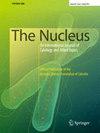Recent Results from the Strong Interaction Program of the NA61/SHINE Experiment and Physics Plans Beyond 2020
IF 2.6
Q4 CELL BIOLOGY
引用次数: 1
Abstract
The NA61 / SHINE experiment at the CERN SPS studies hadron production properties in hadron-nucleus and nucleus-nucleus collisions. The experiment performs unique measurements for physics of strong interactions as well as important measurements for neutrino and cosmic-ray physics. Results from the strong interaction programme indicate a threshold for formation of large clusters interpreted as the onset of fireball. A scaled-factorial-moment analysis of the proton density fluctuations in Ar + Sc collisions at 150 A GeV = c shows an intermittency signal, which may be a first trace of critical behavior. The main objective of the future NA61 / SHINE program is to obtain high-precision data on charm hadron production. This new program is planed to start after 2020 and requires significant upgrades of the NA61 / SHINE detector setup. Besides the construction of a large accectance vertex detector, a 10-fold increase of the event recording rate is foreseen. plasma and the search for the predicted critical point. A scan of the phase diagram of strongly interacting matter was done by changing energy and size of the collision system (from p + p to Pb + Pb in the beam momentum range 13 A (cid:4) 150 A GeV = c ). Various observables, e.g. quantities measuring event-to-event fluctuations of the particle multiplicity, which are expected to reveal the occurrence of a phase transition or of critical behavior are examined. The experimental program has recently been extended by measurements of charm hadron production in nucleus-nucleus collisions, which are expected to provide an additional insight into the phase transition behavior of hadronic matter. For this purpose, a vertex detector was constructed to meet the challenges of open charm measurements.NA61/SHINE强相互作用计划的最新结果和2020年后物理计划
欧洲核子研究中心SPS的NA61 / SHINE实验研究了强子-核和核-核碰撞中的强子产生特性。该实验对强相互作用的物理学进行了独特的测量,同时对中微子和宇宙射线物理学进行了重要的测量。强相互作用程序的结果表明,形成大星团的阈值被解释为火球的开始。对150 A GeV = c的Ar + Sc碰撞中质子密度波动的比例阶乘矩分析显示了一个间歇性信号,这可能是临界行为的第一个痕迹。未来NA61 / SHINE计划的主要目标是获得粲强子产生的高精度数据。这个新项目计划在2020年之后启动,需要对NA61 / SHINE探测器设置进行重大升级。除了建设一个大的接收顶点检测器外,预计事件记录率将提高10倍。等离子体和寻找预测的临界点。通过改变碰撞系统的能量和大小(从p + p到Pb + Pb,光束动量范围为13 A (cid:4) 150 A GeV = c),对强相互作用物质的相图进行了扫描。各种观测值,例如测量粒子多样性的事件到事件波动的量,预计会揭示相变或临界行为的发生。最近,通过对核-核碰撞中粲强子产生的测量,实验程序得到了扩展,这有望为强子物质的相变行为提供额外的见解。为此,构造了一个顶点检测器来解决开放粲数测量的难题。
本文章由计算机程序翻译,如有差异,请以英文原文为准。
求助全文
约1分钟内获得全文
求助全文
来源期刊

Nucleus (India)
Biochemistry, Genetics and Molecular Biology-Genetics
CiteScore
3.90
自引率
0.00%
发文量
26
期刊介绍:
The journal publishes original, peer-reviewed articles on new and significant advances in all aspects of cell and chromosome research. Timely and substantial articles in the areas of cell biology, genetic toxicology, chromosome evolution, cytogenetics; molecular-, population- and evolutionary genetics; epigenetics; developmental and stress biology; transcriptomics, structural and functional genomics, proteomics, metabolomics, integrated omics and use of tools of bioinformatics in the areas stated herein. Studies demonstrating the use of modern approaches such as genome editing to address technological problems and/or biological questions pertaining to the research areas mentioned above are encouraged. However, the studies should be conducted with appropriate scientific rigor in the design, conduct, validity, and interpretation of results to ensure reliability and reproducibility of the data presented. The papers must be written concisely and be of interest to a broad audience.
The journal also publishes comprehensive reviews on current developments and future trends in cell and chromosome research. Such articles should be authoritative, covering all the aspects of a chosen topic, and serve as a resource for students, researchers, and multidisciplinary audience. Authors are welcome to contact the Editor-in-Chief to discuss their topic of interest while preparing a prospective review article.
Thematic special issues on cutting edge research in the development of the above stated areas are periodically published by the journal. Articles for such issues are commissioned by the respective topic editor/s.
 求助内容:
求助内容: 应助结果提醒方式:
应助结果提醒方式:


